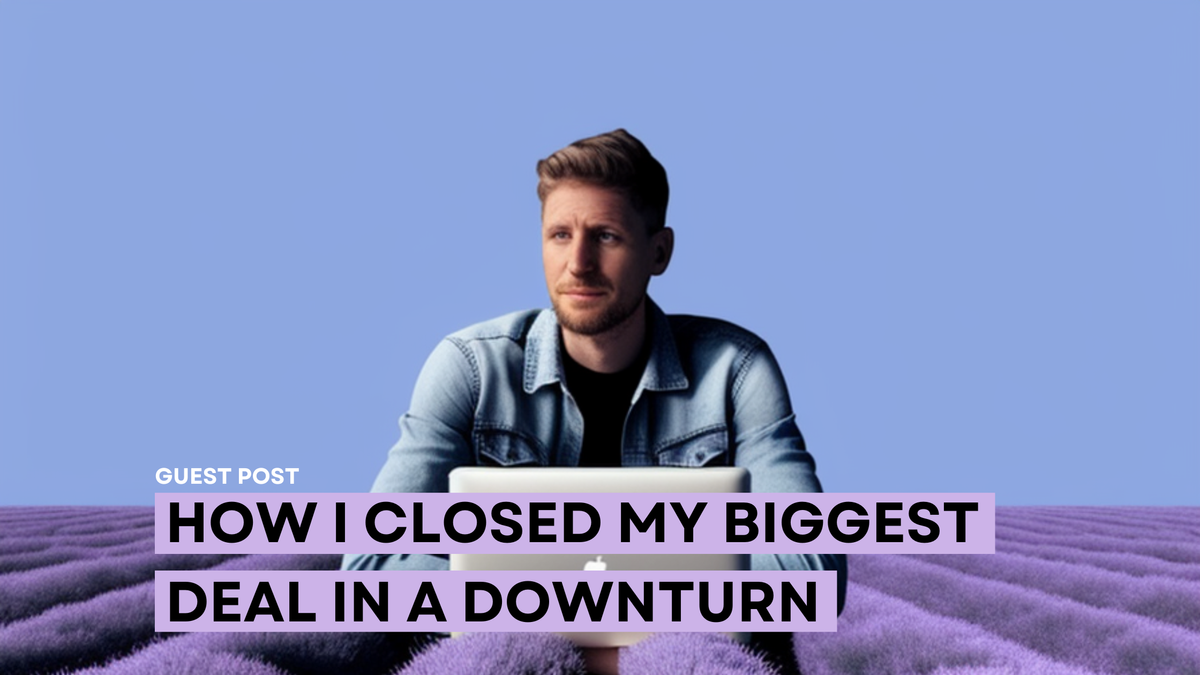How I closed my biggest deal during a downturn
Dealmaking is a challenging science and art. Especially in difficult economic times. Learn how unconventional strategies, from 'nearbounding' to video messages, helped close a 400k ARR deal in a pandemic.

I closed my biggest deal with a travel company in the middle of the COVID-19 pandemic. It was a challenge in itself, but it stood out because the deal was 400k ARR when the average deal size was 17k.
I won’t tell you you need strong discovery. I won't tell you you have to multithread into accounts. You won’t find any "you need access to power" and all that jazz here. Yes, these are all important, but they’re table stakes. They won’t get you signatures when the economy flips on its head.
Instead, I’ll walk you through how I used five less-used techniques to close this deal a full quarter ahead of time.
How do I get in?
Ask anyone, and they’ll tell you the most challenging part about selling in a downturn is getting “in.” You’re told your prospect already has a solution in place, there’s no budget, or this isn’t a priority — and that’s if you get a reply at all.
To get a foot in the door, you need insights. The sources you’ll want to use are industry news, company blog posts, 10-K financial reports, and talking to people who recently left the company (or those who still work there.)
That’s exactly how this opp started. A colleague of mine had a friend at the company, and they were casually catching up. As they were talking, a topic came up. This company wanted to migrate from its existing solution to something easier to manage.
This is what people mean when they say “nearbounding.” Find people close to the account who can get you an intro and share insights so you can lead with value.
How do I get buy-in for the project?
Having a good point of view alone doesn’t mean the project will get funded. At some companies, people were let go to keep the company afloat, remember? Those who remain now have to do 1.5-2 people's work. You’re fighting budget constraints and a lack of capacity.
If you have a strong business case, budget can be allocated from one project to another, and capacity can open by shifting priorities. For that, you need to remember that every decision companies make is about making money. The three main buckets are growing revenue, increasing profitability, and reducing operational risk.
This is the kind of thinking experts mean when they talk about business acumen.
During discovery, I found that this aforementioned project isn’t about budget cuts. It was about mitigating operational risk. The system in question was at the core of how they acquire users.
The problem was that the people who maintained their pre-existing system were no longer with the company. Sure, they wouldn’t mind if they saved a few dollars in the process. But this meant that if I could find out what they are currently spending, I’d have a safe bet on how to price my offer.
I couldn’t get the exact figures, but thanks to nearbounding and deep discovery, I could safely assume the amount they were spending currently was in the ballpark of 500k. Now we’re talking!
How do I keep momentum?
Getting a slot in someone’s calendar is hard enough, but when people are working overtime, it’s a whole other level. Group meetings would’ve taken me two to four weeks to set at a time, so that was out of the question. I needed a way to keep momentum async.
The problem I used to face when working async, is that messages can be long and boring, especially when there’s a lot to discuss. Name one person who will read a wall of text, right? This opp was no different, and that’s when I started doubling down on video messages. And to increase my chance of getting responses, I created video messages while multithreading.
If multithreading is new to you, here's the TL;DR. It’s about having separate conversations with your stakeholders as opposed to using group emails and meetings.
In my case, I had separate threads with each coach and my champion during the deal. Whenever I needed to verify something or share an update, I showed it in a three to five minute screen recording. Then, ask for feedback. If you’re interested in all the five ways I used video messages during my deals, check out this article I wrote.
Does that mean all group conversations were off the table? No, but in keeping them to key milestones in the project, I could make faster moves by working one-on-one. The next step was to make my prospects feel safe.
How do I de-risk the deal?
Have you ever bought a product you’ve never used or know how it worked? Unlikely. That’s why we have free trials and POCs before buyers make a purchase. Not only does the project not stop there, people are more risk-averse during a market downturn. They won’t stick their neck out unless they’re confident the chances of failure are near zero. You have to de-risk the deal for them. But how?
By now, you might have heard about buyer enablement and mutual action plans (MAP) It comes up a lot when we talk about complex deals — because they work.
As part of this project's business case, we created a MAP for the POC and the onboarding. Then, we got buy-in for the package before the evaluation started. The last thing we wanted to do was waste everyone’s time on an initiative that will get shut down.
With our buyers having complete visibility into four things, we were ready to roll. They were the outcome, the likelihood of success, timelines, and the effort required. Large-scale projects like these don’t succeed without defining who does what and by when.
But don’t fall into the trap of creating a plan and laying it out for the team. Building the plan together is how you get stakeholders to play ball.
Now, it was a matter of sticking to the timeline we agreed to.
How do I create urgency?
There we were: two weeks left in Q1. The POC was successful, and the budget was on point, but the buyers didn’t have to make a move until the end of Q2. They were on an annual contract with their current solution, and the renewal date was the end of Q3. We didn't need more than two months to migrate to our product. I needed this deal to hit my number, so I put my champion to the test.
It had nothing to do with incentivizing with blind discounts, which is all too common in SaaS. Nothing around “What would it take to close this deal by the end of quarter?” I had to understand where they were coming from.
To keep budgets in check, they didn’t want to “pay double” to get the job done during Q2. They would’ve paid for the existing solution and ours if they signed the contract. There was around 90k USD left on the prorated contract. So I had to ask: “[Name] let’s say you didn’t have to face these sunk costs. Is there anything else keeping us from moving forward with this deal?” Turns out there wasn’t.
We ended up offering to “buy them out” of their contract. This meant that the buyer got the solution for 400k instead of 488k ARR for the first year. The deal closed on the last day of the quarter, and we were looking forward to an 88k upsell at next year’s renewal.
What were the five techniques?
- We got insights and an intro by nearbounding the deal.
- We aligned our offering with a top-level objective, in this case, mitigating operational risk.
- I used video messages to get things done async.
- We created a clear MAP to de-risk the deal from start to finish.
- And we offered to buy out the incumbent in exchange for signing now.
I’m using “we” on purpose because around 15 people from the sales organization supported me. As well as product, marketing, sales engineering, platform engineering, security, legal, finance, and senior leadership. Everyone got involved to close this whale.
I hope this example gives you the confidence that you can, too.
Author bio: Viktor has ten years of full-cycle experience in tech sales. His latest contribution was helping Bitrise scale from 3M to 20M USD in revenue. For more enterprise sales tips and tricks, follow Viktor on LinkedIn.




